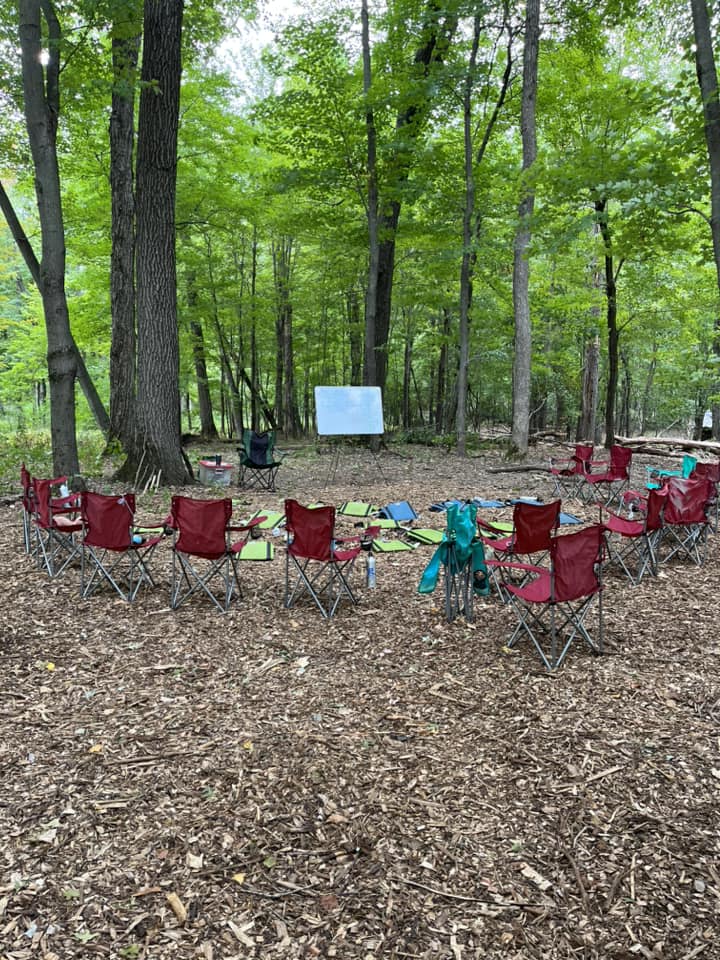I know most teachers don’t have the freedom to create their curriculum, but that doesn’t mean you can’t change things up with the curriculum you have to use. You don’t always need to use technology to engage children. Change things up and provide variety by getting kids out of their desks and out of the classroom. The following are some ideas to get you thinking about integrating the outdoors and movement into the lessons you already need to teach.
Outdoor spaces available for your use
The first thing you need to do is think about the outdoor spaces available for your class. The best thing would be a school forest next to your school that is easily accessible. Suppose you have a park nearby that has trees or a playground area. Think about what nature areas you have. Your school may have a community garden or a big open green space. Sometimes, you have to think outside the box with what resources you have available.
Morning meeting sit-upon
Many teachers have morning meetings every day. There is nothing to say you have to do it in a classroom. You could take your class outside, even if it’s on the blacktop. One concern with this is the grass being wet still in the morning. Have the kids stand in a circle for the meeting. You could also bring some sit-upon. One easy sit-upon you could make for each student in class uses a large 2-gallon Ziplock bag and some newspaper. If you don’t have a newspaper to put inside them, you could find some other material. The Ziplock bag is waterproof, so it will keep the kids dry when they sit on it. The newspaper folded up, or other material provides cushion and keeps the bag rigid by providing a square for kids to sit on. I made this type of sit-upon for my second graders; they are light and easy to carry. You want the 2-gallon Ziplock bags because they make a nice size square for kids to sit.
Another type of sit-upon is made with duct tape, reusable shopping bags, or vinyl tablecloths. If your students are older and able to make their own, this could be an option. Here is a link to a site that explains how to make a duct tape sit-upon.
Questions and answers
Turn into a movement activity outside any questions and answers you want students to do that might typically be on a worksheet. Put the questions on different sheets of paper with a number corresponding to the problem. Then, give the students a clipboard with a sheet with all the problem numbers, with a line next to each number, on which to write their answer. They must find the problem outside and write their answer on the line corresponding to the problem number. Try dry-erase boards and markers if you don’t want to use paper and clipboards. You could only have each student do five problems, not all of them you put out.
Where to put questions outside
The problems can be pinned to trees, taped to playground equipment, stuck on outside school building walls, or put in plastic eggs scattered across the open green space area. If you use plastic eggs, you could write the problem number on the outside of it. I usually did math problems like this, but you can do any question and answer. You may have comprehension problems from a story you read or that they read. The possibilities are endless.
Problems some students have with this activity
One issue I encountered was that students didn’t want to do problems out of order. They would search for the number one to do first and then not finish the activity. You have to make your expectations clear that they find one problem and write the answer next to the number corresponding to the problem number. You might have to model this a few times.
Alternative ways of doing the activity
An alternative way of doing this activity is to check their answers by finding them pinned on trees or taped to something. Have them do the questions first and then let them find the problem with the answer to see if they were correct.
Doing less work for the teacher
At the end of the activity, I had the students collect all the problems and pins to put them on trees. If they are older, you could also get them to put the problems up to begin with. Give each student a question and a pin. Then, tell them to find a tree. You could do the same thing with plastic eggs or tapping something on a wall or playground equipment.
I recommend laminating the problems if you want to repeat this activity with the same questions from year to year.
Reading Outside
Students can always read outside unless it’s too wet. One way to make it fun is to use hammocks. Using hammocks can be challenging if you don’t have a lot of trees around to hang them. One school I worked at had posts put in the ground and hammocks put up on the posts. They had enough hammocks that one class at a time could use the area, and everyone would have their own hammock. Then, classes would sign up for a time they could use the reading hammocks.
Reading anywhere outside can be helpful. If you can get away from traffic noise, it’s better, but not everyone can get to quiet, peaceful nature spots. If you have enough trees, spread the students out by having every student sit next to a tree. This tree could be their reading tree. Have kids bring a towel or blanket to school to lie on and read outside. They can even partner read.
Many schools offer Daily Five or a reader’s workshop program. These could all be done outside, and writing can even be done outside.
One issue you might encounter is if it is a windy day. I then avoid having students read or write outside because it will be harder for them to finish work.
Many teachers read aloud to the whole class. Reading aloud outside is something the teacher can even do outside on a windy day.











Leave a Reply